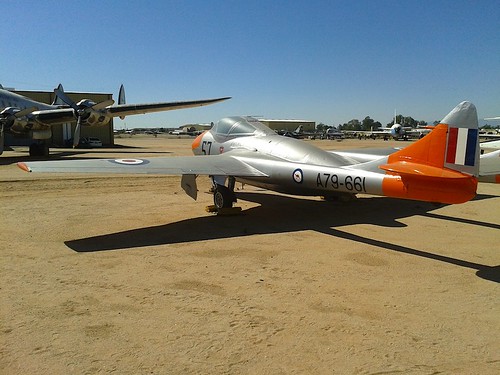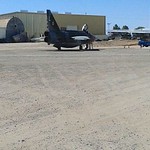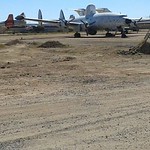I went down to the Pima Air & Space Museum for a volunteers’ meeting and while there took some photos with my cell phone camera, feeling quite the spy. This first photo, for example, was taken inside a storage room not open to the public. It’s a Japanese Kamikaze flying bomb, and there can’t be many of these still laying around. I don’t know when the museum plans to put it on display. I believe it’s on loan from the Smithsonian.

Initially I identified this as a Nakajima KI-115 Tsurugi, because that’s what’s stenciled on the wooden box to the left, but a Facebook friend set me straight and pointed me to the Yokosuka MXY7 Ohka page on Wikipedia. These were single seat rocket powered Kamikaze flying bombs carried aloft by Japanese bombers and dropped in the vicinity of American and allied ships. The Kamikaze pilot would initially glide while picking the ship he intended to attack, then light the rocket motors to accelerate to speeds well in excess of 500 mpg during his final dive, making himself very hard to hit with anti-aircraft fire.
Our Ohka is a two seat trainer. Presumably the techniques necessary to successfully glide, then light the rockets, then steer toward a target at high speed were different enough from those used in normal flight that prospective Kamikaze pilots had to be trained first.
Talk about guts.
I realized later there’s a Tsurugi in the storage room as well, which explains the wooden crate. It was also a Kamikaze plane, built cheaply and powered by whatever spare engines the Japanese had laying around during the final months of the war. I didn’t take a photo, but will the next time I can sneak into the room. It too is on loan from the Smithsonian, and is the only surviving example in the world.
Later that morning I walked over to the fence by the restoration yard and hanger to see what might be in work there. The restoration folks work miracles, given the rusted piles of scrap they start with. Here’s a de Havilland Vampire they recently restored and put on display:

But on to the spy shots. I suppose now I’m a volunteer team leader I can legitimately ask permission to tour the restoration yard and hangar and possibly take better photos. But I haven’t asked yet, and these were all taken from a distance with a crappy little cell phone camera.
I focused on three aircraft: a BAC Lightning that’s almost done and ready to go on display, the fuselage of a 1950s jet fighter I believe to be a Dassault Mystère IV, and a USAF EC-121 airborne early warning aircraft from the Vietnam War era, the predecessor to today’s AWACs. You can click on the thumbnails to enlarge them.
 |
 |
 |
You’ll see a couple of other aircraft, or parts of them, in these photos. The Lightning is parked next to a USAF KB-50 tanker that’s being cleaned and polished prior to going back on display; leaning up against the quonset hut are the Mystère’s wings and tail section; and hey, there’s a T-37 Tweet by the blue pickup truck … my first jet! In the middle photo there’s a two-seat Harrier to the left of the Mystère’s fuselage; behind the Harrier is a WB-57 Canberra with the extra-large wings for high altitude flight; off to the right is the cockpit section of some sort of cargo aircraft. There’s a mix of aircraft behind the EC-121 in the last photo, some of which I can’t really identify, but I’m certain one is a C-9 Nightingale, the military medivac version of the DC-9; there’s also a DC-7 that’s been converted to a water bomber and a C-119 Flying Boxcar.
Okay, next mission: get permission to tour the restoration yard and hangar. I love this stuff!